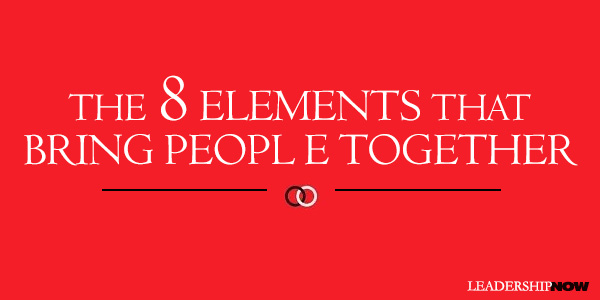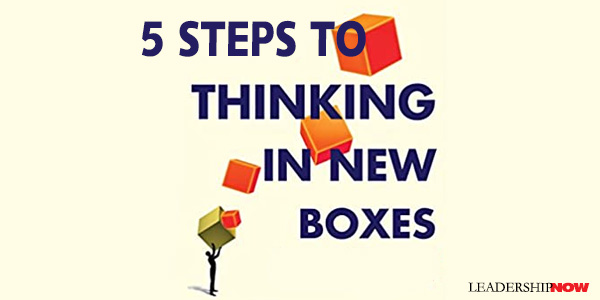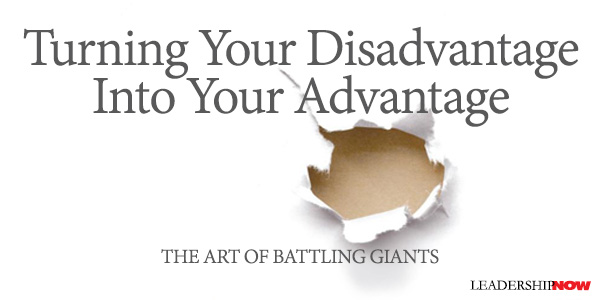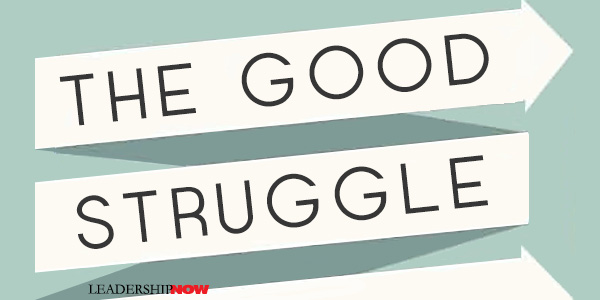 Leading Blog | Posts by Month |
 Leading Blog | Posts by Month |
10.31.13

LeadershipNow 140: October 2013 Compilation
See more on
Posted by Michael McKinney at 08:20 AM
10.30.13

The 8 Elements that Bring People Together
WORKING together to solve a common problem provides us with a more complete picture of the problem, and can offer us more options, synergies, and solutions than we could achieve by working alone. Many of the issues we face will require collaboration at some level to solve or even manage them. In Finding Allies, Building Alliances, authors Mike Leavitt and Rich McKeown, state, “The ability to get things done with collaborative networks is the next generation in human productivity.” We need to be able to form and work with and through value alliances. Value alliances are “a group of participants with aligned interests in pursuing an outcome with value for each of them.” These alliances can last long enough to solve the issue they came together to solve or they can be ongoing as an alliance enterprise to oversee the solution to the problem. But value alliances are not always easy. “Value alliances require that participants subordinate their egos, their agendas, their preferred styles, and their biases—not to mention their organizational agendas—in favor of a shared benefit.” Some people just don’t have the aptitude—the collaborative intelligence, if you will—to work well with others. “People with high collaborative intelligence make an effort to understand the views and needs of others; they listen honestly, thoughtfully, and objectively. They don’t lock into positions prematurely. While they may possess strong points of view, they make an effort to hear other perspectives and will adjust their points of view once convinced they need adjusting.” The authors have had a lot of experience creating, working with, and successfully resolving problems through effective value alliances. They share the good and the bad and the lessons learned along the way. They answer why you form value alliances, the eight key elements required for a collaborative effort to succeed, how you select productive participants, and how you deal with the inevitable issues that come up dealing with other people. Their case is well thought out and clearly presented. From their experience, they have discovered why some collaborative efforts have failed and why others have succeeded. From that background, they detail the 8 elements required for a collaborative network to succeed: 1. A Common Pain is a shared problem that motivates different people/groups to work together in ways that could otherwise seem counterintuitive. Value alliances “exist at the intersection of self-interest and common interest.” We often become collaborators when we discover that we can solve a problem on our own. “Few people are willing to place themselves in a collaborative position of they have an alternative.” (As a side note, leaders, because of their position and the authority it brings them, usually have an alternative—my way or the highway. The best leaders collaborate anyway.) Collaborations require time, money, and people. The collaborative process is more complex, slower, and messier than independent decision-making. To be willing to give up a degree of independence and control, a given leader must believe the problem poses a serious threat to the enterprise. 2. A Convener of Stature is a respected and influential presence who can bring people to the table and, when necessary, keep them there. “The inability to turn down an offer is one sign that you’re dealing with a convener of stature.” The book lays out the roles and responsibilities of the convener. 3. Representatives of Substance. The collaborative participants must bring the right mix of experience and expertise for legitimacy and have the authority to make decisions. Look for participants who possess at least one and ideally all three varieties of substance: authoritative, cognitive, and reputational. Sometimes it is wise to create additional layers of participants beyond the primary or core group. “Omitting people from the collaboration often guarantees that they’ll become external critics or even saboteurs.” 4. Committed Leaders are individuals who possess the skill, creativity, dedication, and tenacity to move an alliance forward even when it hits the inevitable rough patches. Value alliances require committed leaders who fulfill many of these ten roles: organizer, diplomat, technician, teacher, counselor, matchmaker, salesperson, referee, judge, and disciplinarian. “If committed leaders can consistently achieve consensus, they will move the alliance forward. Finding consensus is an art form that alliance leaders must master.” 5. A Clearly Defined Purpose is a driving idea that keeps people on task rather than being sidetracked by complexity, ambiguity, and other distractions. It is important to identify and deal with purpose creep—“an inexorable broadening of scope that eventually makes it impossible to relieve the common pain that drew the group together in the first place.” The authors provide a step-by-step guide to creating a purpose in a collaborative setting. They advise, “Find a golden mean: big enough to matter and small enough to do.” And add, “As a committed leader, you need to develop a sixth sense for when people are setting goals that are too difficult to achieve or too wide-ranging; you also need to grasp when you’ve shrunk the purpose to the point that its achievement won’t have any real impact.” 6. A Formal Charter establishes rules that help resolve differences and avoid stalemates. The three crucial parts of a charter are: the Purpose section, the Principles section, and the Operating Procedures. 7. The Northbound Train is an intuitive confidence that an alliance will get to its destination, achieve something of unique value, and that those who aren’t on board will be disadvantaged. The idea is, “decisions that matter to me are going to be made, and I need to be there. The train is headed north, and I want a seat on it.” They explain why a northbound train slows and what to do about it. “The feeling generated by a northbound train is what carries the collaboration to its destination.” 8. Defining Common Ground. “Participants and leaders need to discuss the beliefs and ideas that they take for granted in their collaborative efforts.” A Common Information Base keeps everyone in the loop and avoids divisive secrets and opaqueness. “Defining common standards boils down to the capacity of collaborators to reach foundational agreements.” People are coming from all different places with different values and beliefs, but to get to the point where there is a recommendation or decision that everyone can buy into and to hold the collaboration together until that point is reached, “Agreement about operating modes and information protocols is necessary.”

Posted by Michael McKinney at 12:43 AM
10.28.13

5 Leadership Lessons: The Heart of Leadership “Leaders are different,” begins Mark Miller’s The Heart of Leadership. “They see the world differently and they cultivate different character traits.” It’s a business fable that explains that “you can have impeccable character—be honest, loyal, dependable, and so on—and still not demonstrate leadership character.” Leadership character sits on top of these traits and are foundational. Leaders who don’t possess these traits and others like them, are disqualified before they start. Skills are important, but “if you don’t demonstrate leadership character, your skills and your results will be discounted, if not dismissed. The Heart of Leadership is a well told story and is built around five lessons: The key issue though is discussed at the end of the story. If these qualities don’t become part of who you are, your leadership will never really change. Our leadership reflects who we are inside. You can fake it for a while, but eventually it will come out. “If you do all those activities and your heart doesn’t change, you won’t be the kind of leader you want to be. Leadership is not about what you do nearly as much as it’s about who you are becoming—the heart of leadership is a matter of the heart.”

Posted by Michael McKinney at 12:01 AM
10.24.13

How to Discover Your WhatYour WHAT is the “single most crucial element of your life that needs to be identified, defined, and fulfilled,” says Steve Olsher in What is Your What? Here’s why:Your unfulfilled WHAT will absolutely affect you in a variety of unexpected ways. It could be the source of your high blood pressure, the reason you don’t feel “good enough,” the cause of your general sense of loathing when you wake up, or the impetus behind your efforts at self-sabotage. It should be noted here that finding your what is not a surefire way to fame and riches—or gainful employment for that matter. And while each person is unique, many others possess similar abilities and may fill a need in the marketplace better than you do. It takes work. At the same time, some people chose to work at jobs that do not fulfill or satisfy their what because it fills a purpose or a value that they consider to be greater than their own personal needs. Perhaps that is their what. That said, What is Your What? will help you get to gain control over your life rather than letting it happen haphazardly. What is Your What? is a self-awareness book to help you connect with who you really are. What you do from there is your choice. Olsher has developed a three-step process to help you uncover and reconnect with your natural strengths, identify the vehicle you’ll leverage to share your gifts with the world and the specific audiences who’ll benefit most from your gifts. “As we endure life’s hardships, we tend to lose touch with our inner greatness. We start to make distasteful compromises, settle for less, and become people different from our deepest selves.” Becoming aware of how you were knocked down is the first step in ascending to your most natural state of being. Olsher bases his program on seven principles: 1. Recognize YaNo Moments. These are those moments when you are faced with a choice. Some are big; some are small. “Any time you undertake an activity without evaluating the impact your choice will have on your life, you run the risk of compromising your state of mind. The key to regaining control of your life is to make deliberate choices with an understanding of the consequences.” 2. Reclaim the Canyon. Establish space between life as it happens and your reaction to those events. 3. The Sufficiency Theory. Attain satisfaction, peace, and contentment by minimizing material desires and the effect of outside influences. Olsher suggests that we stop drawing lines in the sand. “Happiness is not a destination that can be reached by attaining select milestones. Shift your approach from waiting for certain things to happen in order to feel a certain way to feeling and acting that way now. Surprisingly often, this will spur the results you desire to happen.” 4. Retrain Your Brain. “Anything from your past that you choose to relive becomes a part of your identity. Be careful about which memories you commit to.” 5. Incorporate Jack Welch’s successful business practices into your behavior. Specifically, become highly focused on who you are, what you stand for, and what your purpose is; identify the Top 20 Percent, Vital 70 Percent, and Bottom 10 Percent for each area of your life; achieve Six Sigma in all key aspects of your life and strive to accept nothing less than your best. 6. The Not-So-Golden Rule. Eliminate fear or expectation as a motive for your actions. Your motive does matter. Act out of love, without the expectation of anything in return. 7. The Slow Death of Not Being the Star. Shift your focus away from time-consuming distractions and toward the pursuit of your personal goals. Keep track of your activities for a week. “Chances are you’ll find that what you’ve been thinking of as relaxing ‘downtime’ is actually the dominant force in your life, devouring months and years you can never get back.” 
Posted by Michael McKinney at 09:56 PM
10.16.13

5 Steps to Thinking in New Boxes
THINKING outside-the-box is a useful metaphor for thinking creatively or trying to get out of a rut. But practically speaking, it’s not going to happen. Your brain just doesn’t work that way. Your brain needs boxes. You can’t think without them. We create and use mental boxes to organize and use what we know. The reality is, getting out of one box means getting into another. Thinking outside-the-box really means finding a new box. A new box with different assumptions, prejudices, beliefs, and parameters. A different box will give you different answers because it forces you to ask different questions. In Thinking in New Boxes, authors Luc de Brabandere and Alan Iny say that the improved solution will be found in a new box. Here’s the key thought: “Since your brain needs models or boxes to think, the key to being creative in practical ways, to managing change during these times of such uncertainty, is to first try to understand your existing boxes to a greater degree, and then attack any situation or issue by developing a range of new boxes. You can then carefully choose which box(es) to use, even as you embrace the ambiguity inherent in doing so.” Based on how the human mind actually thinks and reasons, the authors have developed a five-step approach to thinking in new boxes: Step 1: Doubt Everything
Step 2: Probe the Possible
Step 3: Diverge
Step 4: Converge
Step 5: Reevaluate Relentlessly
Thinking in new boxes is first about being aware of the box you’re in and why you’re in it. The reason many find it difficult to change – to move to a new box – is because they don’t know why they think and do what they do. Once you do, it’s easier to see where you need to go and what you need to do. 
Posted by Michael McKinney at 11:46 PM
10.13.13

Turning Your Disadvantage Into Your Advantage
MALCOM GLADWELL wants us to rethink how we think about the giants in our lives whether they be outsized opponents, disabilities, misfortunes, or oppression. We all face or have faced odds that seemed to be stacked against us. Odds that we are forced to deal with. In David and Goliath, Gladwell shares two ideas. First, “much of what we consider valuable in our world arises out of these kinds of lopsided conflicts, because the act of facing overwhelming odds produces greatness and beauty.” The battle makes us better. It develops us and reveals strengths that we didn’t know we had.Second, giants are not always what we think they are. The powerful and strong are not always what they seem. Often their strength can expose their greatest vulnerability. Their size can be their undoing. What we see as their overwhelming advantages can also be the thing that limits their options. We know but easily forget, that there is a point where more doesn’t make a difference and more still becomes a disadvantage. “We all assume,” writes Gladwell, “that being bigger and stronger and richer is always in our best interest.” A wealthy man told Gladwell about the relationship between wealth and parenting: My own instinct is that it’s much harder than anybody believes to bring kinds up in a wealthy environment. People are ruined by challenged economic lives. But they’re ruined by wealth as well because they lose their ambition and they lose their pride and they lose their sense of self-worth. It’s difficult at both ends of the spectrum. There’s some place in the middle which probably works best of all. Gladwell is a master storyteller. The stories are compelling and at times provocative. But they all make you think. Gladwell makes the point that certainly some people triumph over their disabilities in spite of them. They simply won’t let them stand in their way. But there are those that succeed because of their disability. “They learned something in their struggle that proved to be of enormous advantage.” Challenges can cause us to develop skills we might not otherwise have developed if we choose to respond that way. Although Gladwell makes the point that there are “desirable disadvantages,” in that it is the difficulty that eventually led to a person’s success and made them a better person, it is not to suggest that we should wish for more disadvantages or wish them on other people. We all have disadvantages, some are huge and some are not, but the lesson is in how we see them. How we react. Some of what we perceive as advantages—opportunities or resources that we wish we had—have actually ruined people or diminished their full potential in some way. The thread that runs through all of Gladwell’s examples is how individuals or organizations turned their disadvantages to their advantage—how they defeated giants by reframing their perceived advantage. There is no formula here as to what will work and what won’t. The question is as it has always been, how will you respond to what you have been given? The key lesson is that for the most part, difficulties are what you make of them. 
Posted by Michael McKinney at 09:16 PM
10.09.13

The Good Struggle NOT surprisingly, Joseph Badaracco has written an essential read for leaders of all kinds. The Good Struggle addresses the question of how to lead successfully and responsibly in our uncertain, high pressure, turbulent world.
NOT surprisingly, Joseph Badaracco has written an essential read for leaders of all kinds. The Good Struggle addresses the question of how to lead successfully and responsibly in our uncertain, high pressure, turbulent world.
Badaracco says that the inescapable pressures of leadership are intensified today because of the market-driven world in which we live. “Almost everything—how we manage our organizations and our lives, how we make decisions at work and at home, and even how we think about ourselves—is deeply shaped by markets and market-based thinking.” This creates greater uncertainty, obscures right choices, and puts pressure on us to abandon principles that we used to rely on. Responsible leaders find themselves engaged in the good struggle: “a long effort, demanding perseverance and courage, to make good on serious but profoundly fallible commitments in an uncertain and often unforgiving world.” He adds, “Struggle has always been central to accomplishing anything worthwhile, and this is especially true today.” He offers five enduring—inescapable—questions. Responsible leadership consists of thoughtful and lived answers to them. Am I Really Grappling with the Fundamentals? “The first responsibility of leaders is intellectual. It is the struggle to develop—to the extent possible—a deep, careful, analytical, data-driven understanding of the driving forces in the markets and society around them and to keep this understanding loose, flexible, and revisable.” Grasping the fundamentals can “reduce the chance of being blindsided, by encouraging the mental habit of looking for emerging patterns and odd developments with larger implications. It also promotes modesty, a healthy, low-level paranoia, and vigilance rather than hubris.” He notes that everything now is modular—constantly being recombined. “Recombination also makes it much harder for leaders to inculcate values when people in their organizations know they and their leaders are basically modules in a plug-and-play world and could be moving on soon. The natural instinct is to take care of yourself, here and now.” What Am I Really Accountable For? “Without clarity about accountability, leaders and their organization can drift or zigzag aimlessly.” Of course, many leaders do not want to be accountable to anyone or anything. “Accountability originates in an obligation to make good on the spirit of some jointly designed, provisional, and evolving objectives.” Here’s the question for any leader: “What pressures, scrutiny, and risks do we want to create or invite in order to build a strong, resilient, responsible organization?” How Do I Make Critical Decisions? We need a broader view of critical decisions. Instead of viewing them as deep, abiding pledges that we must make good on, we need to see them more as evolving commitments. That is, “a pledge, by a leader and an organization, to move in a particular direction, but to do so in a flexible, open-ended way.” Decision making has to be as fluid as the markets around them. “Execution as learning.” “Instead of periodic big decisions, responsible leaders make or orchestrate an unending series of smaller ones—all aimed at some larger, broad, flexible objective.” Do We Have the Right Core Values? Values are important because “they may be the only force that can counter the power of markets and market-based thinking….Today’s ever-present markets have their own implicit values, and they can easily overwhelm whatever values leaders want to instill in their organizations.” To lead responsibly, leaders must commit to “clarity, meaningful projects, and bright ethical lines. In different ways, each of these helps leaders and organizations respond to the risks and opportunities created by pervasive market forces.” Why Have I Chosen This Life? People seek positions of leadership not despite the struggles involved, but because of them. “Responsible leadership is a challenge that—despite its inevitable risks, frustrations, and failures—demands and merits the best efforts of talented men and women, tests their competence and their characters fully, gives purpose and intensity to their lives and helps them lead the kind of lives they really value.” The purpose of our struggle matters. Badaracco writes, “If the purpose of life is ease and comfort, no sensible person would take on the demands of leadership.” Perhaps in developing leaders at all levels we need to change that very prevalent mindset. Without it we can’t discover what we are and the person we are meant to be. Badaracco doesn’t offer hard answers because they are evolving answers and should be individual answers created from introspection and reflection. But the insights and provocative concepts are enough to get you thinking in new ways. 
Posted by Michael McKinney at 11:24 AM
10.01.13

First Look: Leadership Books for October 2013Here's a look at some of the best leadership books to be released in October.




For bulk orders call 1-800-423-8273  Build your leadership library with these specials on over 120 titles. All titles are at least 40% off the list price and are available only in limited quantities. “A capacity and taste for reading gives access to whatever has already been discovered by others.” — Abraham Lincoln
Posted by Michael McKinney at 12:11 AM
|
BUILD YOUR KNOWLEDGE


How to Do Your Start-Up Right STRAIGHT TALK FOR START-UPS 
Grow Your Leadership Skills NEW AND UPCOMING LEADERSHIP BOOKS 
Leadership Minute BITE-SIZE CONCEPTS YOU CAN CHEW ON 
Classic Leadership Books BOOKS TO READ BEFORE YOU LEAD |
|